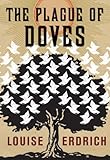 Louise Erdrich’s latest novel A Plague of Doves might be the best book I’ve read this year. I kept turning the pages as the drama that affected an entire town unravels showing the degree to which the traumatic murder of a family and subsequent lynching of innocent parties binds the townspeople together in a fascinating web of history.
Louise Erdrich’s latest novel A Plague of Doves might be the best book I’ve read this year. I kept turning the pages as the drama that affected an entire town unravels showing the degree to which the traumatic murder of a family and subsequent lynching of innocent parties binds the townspeople together in a fascinating web of history.
A Plague of Doves is often compared to Faulkner. Erdrich’s use of multiple narrators as well as the imagery, symbolism, and characters of her novel certainly evoke Faulkner, but readers daunted by Faulkner’s style need not be afraid. A Plague of Doves contains no page-length sentences or stream-of-consciousness meanderings that make it difficult to follow. This story is told from the viewpoint of four different narrators who are all connected to the town’s tragic past in various ways. One of the narrators, Evelina Harp, attempts to parse the connections upon first hearing about the story of the lynching:
The story Mooshum told us had its repercussions — the first being that I could not look at anyone in quite the same way anymore. I became obsessed with lineage. As I came to the end of my small leopard-print diary (its key useless as my brother had broken the clasp), I wrote down as much of Mooshum’s story as I could remember, and then the relatives of everyone I knew — parents, grandparents, way on back in time. I traced the blood history of the murders through my classmates and friends until I could draw out elaborate spider webs of lines and intersecting circles. I drew in pencil. There were a few people, one of them being Corwin Peace, whose chart was so complicated that I erased parts of it until I wore right through the paper. (86)
I drew my own family tree chart in the back of my book and added to it as I read and discovered new connections. After finishing the book, I wish I had thought to make index note cards, as one reviewer did, because the web of relations is so complicated. For all its complexity the story is that much richer and more real.
Several sections of Erdrich’s novel could stand alone as short stories, and indeed, parts of it have been published as short fiction, as I learned on reading Erdrich’s acknowledgments at the end of the book. If parts of the novel feel somewhat digressive as a result, I think Erdrich can be forgiven, for when the reader reaches the last few pages, all the digressions are shown to be pieces of a complex puzzle — the reader doesn’t know what the picture is until the last piece is put in place.
In addition to being a fairly good murder mystery, the novel is rich in imagery, symbolism, and well-drawn characters, and by the end of the novel, I felt like a resident of Pluto, North Dakota and felt sure that I had truly known all of these people and uncovered their bloody history myself. And that, after all, is what a good book should do for us. Go right out and get this book now! It’s amazing! I don’t often post Amazon reviews, but I loved this book so much I want everyone to read it, so this review will be cross-posted at Amazon.
My next book is Brunonia Barry’s The Lace Reader.
Update, 9/12/09: I managed to make my tree look sort of readable using Inspiration. Download it by clicking this link. I hope it’s useful. It probably goes without saying that unless you’ve read the book, you shouldn’t look at it because it reveals the ending.
Plague of Doves Family Tree
I have been working on a Family Tree also…quite fascinating but I have some blanks … would you be willing to share your tree?
Thank you,
Sally
Sally, I'm on vacation. I'll try to remember to scan and upload my tree when I return home.
I would also love to see your family tree. I just finished the book and loved it, but was wishing I had a family tree throughout.
Thanks!
Please please post your tree! We have a book group discussing this on Wed, and I am 2/3 of the way through and wish I had thought of this at the beginning. It would be very helpful. Thanks!
Lauren and Amy, it's up. Sally, I'm sorry it took me so long. Obviously, I forgot after vacation.
Hi Dana, thank you so much for posting the family tree for "The Plague of Doves." I loved the book, but know this will make it much easier for my book club to discuss! Your work is truly appreciated!